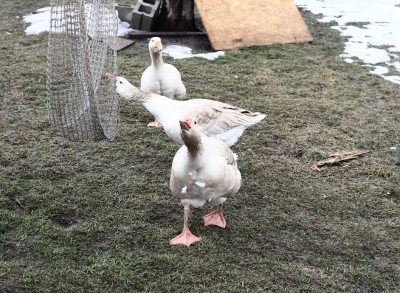
Spring’s arrival has brought big changes and weighty revelations to our backyard poultry ranch, not least of which is the snow melting. Bigger yet, though is this news: our goose is laying! I say “goose,” because, contrary to what our previous beliefs of the gender distribution of our American buff goose flock – that is, two geese, one gander – it’s recently been revealed to us that we in fact have two ganders and one goose. That’s been a tough pill to swallow.
 Photo credit: Brice PortolanoSpring’s arrival has brought big changes and weighty revelations to our backyard poultry ranch, not least of which is the snow melting. Bigger yet, though is this news: our goose is laying! I say “goose,” because, contrary to what our previous beliefs of the gender distribution of our American buff goose flock – that is, two geese, one gander – it’s recently been revealed to us that we in fact have two ganders and one goose. That’s been a tough pill to swallow.
Photo credit: Brice PortolanoSpring’s arrival has brought big changes and weighty revelations to our backyard poultry ranch, not least of which is the snow melting. Bigger yet, though is this news: our goose is laying! I say “goose,” because, contrary to what our previous beliefs of the gender distribution of our American buff goose flock – that is, two geese, one gander – it’s recently been revealed to us that we in fact have two ganders and one goose. That’s been a tough pill to swallow.
A few months back, we slaughtered a goose thinking we had three geese and one gander, namely the Protester. Yeah, he’s a gander, but the Hisser, whom we’d always just thought was an ill-tempered goose, is actually a gander, too.
A lot of observation and deduction and sage poultry wisdom (not ours, I might add) brought about this revelation. So a couple weeks ago, I was interviewing Frank Reese Jr., a highly-respected poultry breeder in Kansas. As we’ve mentioned in previous blogs, the Hisser and the Protester have acted really aggressive lately, hissing and biting almost anybody who enters the backyard. (We’ve started dealing with that more proactively; more to come in a future blog.)
 Notice the prominent knob (the two bulbous lobes) at the top of the Protester’s bill.
Notice the prominent knob (the two bulbous lobes) at the top of the Protester’s bill.
After getting through official interview business with Frank, I asked him about the problems we’ve been having with our geese. Without missing a beat, Frank, who’s passionately dedicated to maintaining and upholding strict breeding standards, stated that the Protester isn’t a purebred American Buff. His aggression, his body posture (upright rather than more parallel with the ground), the knob he’s developed at the top of his beak, his beak’s deep orange hue — Frank said American Buff beaks should be pale orange to flesh-colored, not red-orange; “Their beaks shouldn’t match the color of the feet,” he said after refering the the American Poultry Association’s breeding standards) — and his great size are all uncharacteristic of American Buff geese. “You got a Chinese goose there,” Frank told me. Likely, the Protester has both Chinese and American buff genes.
 The Protester is much larger than the other two geese. His coloring is also much darker, less buff.
The Protester is much larger than the other two geese. His coloring is also much darker, less buff.
There’s also a chance the Hisser has some Chinese genes as well, though the smallest goose – whom we’ve never bothered to name – appears to be more full-blooded American Buff, and Goose, whom we slaughtered last year, likely had even stronger American Buff lineage. Ah, the travails and missteps of novice poultry breeders!

Frank also said that it’s really uncommon for geese, i.e. female geese, to be aggressive. What’s probably happening with the Hisser, he explained, is that she is actually a he and he’s defending his goose and his territory.
We’ve been observing the geese really closely since talking to Frank, and it appears that he’s correct. The Protester and the Hisser hover over the little goose wherever she goes. And whereas she’s docile and wants nothing to do with us whatsoever, the two ganders are on constant alert, vigilantly protecting their goose.
All these revelations pose us some real challenges now. Apparently, it’s not a good idea for a flock to have more ganders than geese, so we’re going to have to cull either the Hisser or the Protester. Given the Protester’s soiled genetics, he’s the most likely candidate for the chopping block. He’s also the goose we’ve grown most attached to. We’ve got big decisions to make in the coming days and weeks.
 The Protester displays very aggressive behavior towards anybody that enters the backyard, especially strangers. He recently bit a guess — who’s technically my boss — causing her to bruise quite badly. (Photo credit: Brice Portolano)
The Protester displays very aggressive behavior towards anybody that enters the backyard, especially strangers. He recently bit a guess — who’s technically my boss — causing her to bruise quite badly. (Photo credit: Brice Portolano)
Oh, and about that goose egg I mentioned at the top: Katherine will post an update about that very shortly, so stay tuned!
